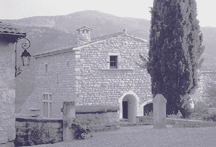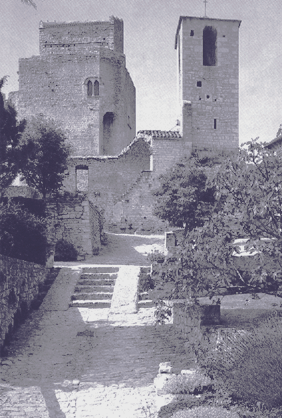

[ Metro Santa Cruz | MetroActive Central | Archives ]
Crosses to Bare
Romancing the Romanesque: At Les Hospitaliers, a historic resort hotel poised on the gateway to Provence, rugged fortress architecture conceals a heart of sheer culinary indulgence.
Scouring the Rhône Valley in search of Crusader ruins
By Christina Waters
Ever since we'd left Lyons, it seemed that the entire country of France had become a vineyard. Grapes to the left of us, grapes to the right of us, into the Valley of Grapes--well, actually the Rhône, which is the same thing--we went. Hugging the west bank of the mighty river that took Julius Caesar all the way up into the Alps two millennia earlier, we drove the unspeakably scenic D68, a well-maintained rural highway refreshingly free of billboards and convenience stores, all the way to Toulouse.
The central concept for this trip to southwest France emerged suddenly--and my companion Rosemary and I always travel with a concept firmly embedded in our American brainpans. Sometimes that concept can be as obvious as "Paris." This time, the end of the trail was a region with the primeval name of Languedoc, and specifically a mountain hermitage started up in the year 800 by a nephew of Charlemagne: St. Guilhem-le-Désert. The very name enchanted me, conjuring visions of barefoot monks in hopsacking wandering the rocks in search of angelic visitations. But when I saw photographs of the 11th-century chapel wedged into sun-baked rocks high above the milky blue Hérault River, I knew that this was the version of the Romanesque I'd been after.
MetroActive Goes Trippin' . . .
Don't Miss Saigon: Playing the Pacific Rim by bike requires stamina and good wheels.
On the Road: Traveling doesn't have to mean planes and trains. Automobiles and thumbs can get you pretty far.
Southern Sunshine: Paradise found on Mexico's tropical beaches.
An Idiot's Guide to the Universe: How to keep Europeans from thinking you're completely hopeless.
Queer Across the World: Transcending homophobia in search of another buck.
Packing Heat: Paranoid or not, it's always a good idea to keep an eye out for danger when you travel.
Virtual World: Armchair travelers can feed their wanderlust on the web.
The other piece of this Gallic pie materialized after one too many readings of Foucault's Pendulum, in which Umberto Eco weaves a postmodern variation on the theme of Knights Templars and other secret, mystical societies. Well, the Templars had famously used the southwest of France, crowned by the port of Marseille, as a staging area for the Crusades. Churches that weren't busy being used by pilgrims grinding their knees into steak tartare en route to the shrine of Santiago de Compostela were all agog about the prospect of looting, raping and pillaging--officially sanctioned as "saving Jerusalem from the Infidel"--in the Holy Land.
The landscape was, I hoped, littered with bits of crusader detritus. As the trip began to take shape, I ran into mention of a crusader fortress that had been transformed into a luxury hotel, a few hours south of Lyons and just a few miles east of the mighty Rhône. It was called, aptly, Les Hospitaliers, after the Templars' rivals, the Hospitallers of St. John, another group of warrior monks who spent as much time building hospitals in a post-crusade mop-up operation as they had looting the coffers of Pharisees and sheiks.
It was these Knights of St. John--later the Knights of Malta--who acquired the ill-gotten wealth of the Templars after the French government (itself in hock up to its foie gras to the men of the rosy cross) declared the Templars outlaw and burned their grand master, one Jacques de Molay, at the holy stake.
The hotel is essentially a renovation of a 12th- to 13th-century chapel, fortress and military compound carved out of a glorious limestone promontory overlooking a fertile valley of the Drôme district. And while it wasn't technically a Templar outpost, the Hospitallers had built it with Templar money, so it fit the trip's concept beautifully.
The Crusader Trail: The sun-soaked pathway winding through the ruins of the 13th-century fortress now houses artists' studios.
Perfumed Views
The fields here at the very gateway to Provence were ablaze with red poppies and the afternoon temperature soared toward the mid-90s as I powered the trusty Audi up a gravel road (so narrow it looked like a footpath) into the parking lot of what looked like a Romanesque ruin on a mountaintop, which is exactly what this former Knights of St. John headquarters was. Below us, like a French country postcard, lay the vineyards and orchards of the Drôme, and beyond, the Italian Alps. The air was spectacularly clear.
Our room overlooked the atmospheric ruins of the fort's chapel, gleaming pale yellow in the lowering light. The most expensive accommodation of our trip--$180 for a double--the room also was the most distinctive, equipped with handsome antiques, mirrored armoire, a modern bathroom complete with hair dryer and a view to kill for. (The guys who originally lived here probably did kill for it, but that's another story.)
Touring the compound, we marveled at how the ruins--now protected by French National Historical Landmark status--had been seamlessly restored, concealing artists' studios within its thick walls and towers, and hosting an annual outdoor music festival that we missed by a mere two weeks.
We were, however, just in time for the other secret weapon of this extraordinary place: dinner. Seated under a flowering almond tree on the great stone terrace that spills along the hilltop overlooking the property's swimming pool and the vast valley below, we began with a huge, lusty cabernet blend from Jean Pierre Forge 1990 made from the vineyards just below the hotel.
I noted with glee the flared crusader cross motif on the house porcelain and silverware as we moved on to grilled zucchini and eggplant, carpaccio strewn with pink peppercorns and shallot confit, and poached lake trout with Pernod-infused tomato coulis. Gourmets from the nearby town of Montélimar had come up for dinner, a single seating that lasted until the stars came out over three hours later. A rack of lamb had been grilled in rosemary and was joined by tiny new potatoes and carrots. We consumed a spectacular cheese course of Reblochon, creamy St. Nectaire and a Roquefort as ripe as an X-rated movie.
Though we refused dessert, French kitchens simply don't take no for an answer, and a profusion of small cakes and cookies accompanied our midnight espresso. And you wonder why I just didn't hunt for crusader relics in Syria?
This page was designed and created by the Boulevards team.

Jean-Cluade Dumont et Pierre Maerten



Christina Waters
Les Hospitaliers Hotel-Restaurant, 26160 Le Poët-Laval, Rhône-Provençal, France. Tel: 75-46-22-32; fax: 75-46-49-99. Reservations graciously taken in English.
From the April 25-May 1, 1996 issue of Metro Santa Cruz
Copyright © 1996 Metro Publishing and Virtual Valley, Inc.